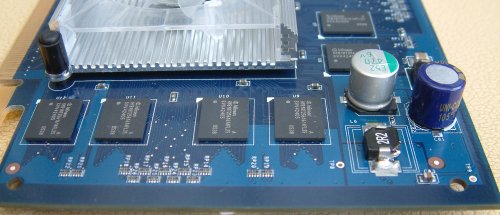Card appearance and thoughts
Let's take reference models as a starting point and ascertain why the GeForce 6600 DDR2 SKU was a much-needed product. Right now, a vanilla GeForce 6600 card clocks in at 350MHz core and 500-550MHz memory, available in either 128MB or 256MB GDDR1-equipped framebuffer flavours. Starting prices of around £60 and finishing off at around £80 for a deluxe model with all the trimmings, it's a decent enough GPU in its own right. The next iteration of current NVIDIA GPU is the GeForce 6600 GT. It carries on over all the underlying architecture found on the GeForce 6600 but, and it's a big one, ramps up core speed to 500MHz and utilises GDDR3 memory that's run at 900MHz upwards (usually 1GHz). Now, with the same architecture, pure clock-speed differential between the two 6600-series GPUs is, really, too large. Add to this the fact that 128MB-equipped GeForce 6600 GTs start at £100 and you can appreciate just why there's a need for an interim product, and that product, NVIDIA's decided, is a GeForce 6600 core running at 350MHz and GDDR2 memory at 800MHz.
XFX has been one of the first manufacturers to release an NVIDIA GeForce 6600 DDR2 retail card and much like previous XFX cards, its version runs with a pre-overclocked core at 400MHz. As mentioned, reference GeForce 6600 designs will ship at 350MHz, but we expect other card partners to follow XFX's lead and release their own SKUs are varying speeds.
The card design is pretty much what you'd expect from an £80 offering. Only a small-ish cooler is needed to keep the NV43 core humming along at 400MHz. Regular GeForce 6600 GTs' cores run at 500MHz upwards, so they've got, ceteris paribus, 25% extra fillrate power. Of course, they also cost around £25 for a 128MB frambuffer-equipped model, too. The aluminium heatsink's fan, although small and spinning at relatively high RPM, doesn't have that annoying pitch that's associated with many low-end cards. It's patently obvious that XFX, and most likely all card partners who produce GeForce 6600 DDR2 cards for that matter, have a keen eye on overall cost, and engineering individual, quieter heatsink/fan assemblies simply isn't viable when, literally, every penny saved counts. Interestingly, XFX has a few GeForce 6600 DDR2 variants in its lineup, including a low-profile, passively-cooled design that would be perfect for the HTPC crowd. A look under the heatsink holds no surprises.
Leading on from this actively-cooled model, the basic heatsink, entirely appropriate for a budget card, doesn't cover the GDDR2 RAM chips that line the upper and right-hand sides. The type of memory chosen here is crucially important for this SKU, as that's how NVIDIA, in the main, will sandwich it between the regular GeForce 6600 that uses basic, comparatively slow GDDR1 chips and the erstwhile GeForce 6600 GT, replete with faster GDDR3 RAM. NVIDIA's pitching reference '6600 DDR2 cards' memory clock speed at an effective 800MHz, and XFX keeps the status quo by using 8 256MBit 2.5ns-rated chip from Infineon. Doing the maths tells us that there's a total of 256MB (or, more correctly, 256MiB) memory on-board, although cards should also be available with 128MB framebuffers in the near future. So, in basic specification summary, you get an NV43 core chugging along at 400MHz that's allied to 256MB of GDDR2 memory, connected via a 128-bit interface, which runs at 800MHz. Performance, obviously, will fall between vanilla GeForce 6600 and 6600 GT cards, with extra-high resolution benchmarking results dependant upon the size of card framebuffer used.

Here you can see the GDDR2 DRAM arrangement a little more clearly. What's also clear is that, being a low-to-midrange card, a x16 PCI-Express slot provides enough juice for you not to need auxillary power; there's no 6-pin power connector that we've seen on all high-end boards of late. The very interface, PCIe, is flavour of the year, and we doubt that an bridged, AGP-equipped model will see the light of day anytime soon. In terms of overall PCB size, XFX's card has the same dimensions as a reference ATI RADEON X1300 Pro 256MB card and both are a little smaller than an NVIDIA GeForce 6600 GT.

Card partners can further differentiate their products from one another, especially in the sub-£100 sector, by adding various features. XFX has gone with a traditional single-link DVI, S-Video (video-out only), and HD15 set of connections on the backplate. Dual-DVI, for those of you who run two DVI-capable TFTs, would have been lovely, though, and is available on a different XFX GeForce 6600 DDR2 256MB SKU. Take another look at this card and you'll note that there's no distinct SLI connector, the conduit that NVIDIA uses for inter-GPU connection. Does that mean no SLI possibility here? The answer is a no, because GeForce 6600 cards don't require external bridging. Two of these PCIe cards would work just fine in various SLI modes, and it's worth noting that SLI has been available for some time.

All of the action is contained on the upper side, and the back is, well, bare by comparison. There's also no temperature-monitoring ASIC on this model, although given the low-power core and basic design, heat shouldn't be an issue.









